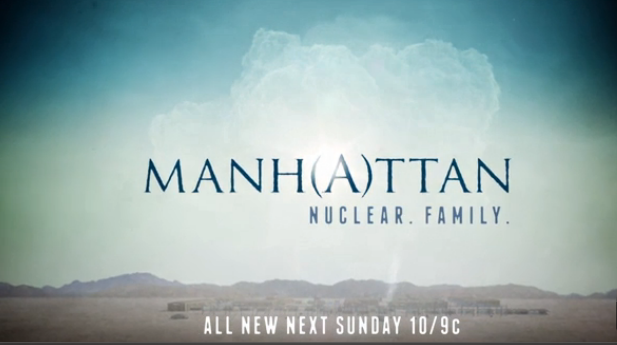 Courtesy/wgnamerica.com
Courtesy/wgnamerica.comLAHS News:
There was another amazing turnout for the Los Alamos Historical Society’s viewing of the second episode of WGN’s new series, “Manhattan,” a fictionalized look at life in Los Alamos during the Manhattan Project.
Below are some of the common questions heard that night and on social media. Every week the Society will be updating a bulletin board in the Museum to continue exploring questions and reactions as the 13-episode series continues. Previous episodes are discussed at www.losalamoshistory.org, on the LAHS Facebook page and in the museum.
Join the Los Alamos Historical Society 8-9:30 p.m. Sundays at Time Out Pizzeria in Los Alamos for a viewing and discussion of Manhattan (TV-14 rating).
Discussion:
Was the Little Theater here?
- The Little Theater did have its first production in 1943. The play was titled “Right About Face.” Performances took place wherever space could be found, such as at Fuller Lodge and the Enlisted Men Mess Hall (Little Theater’s current location). However, the Enlisted Men Mess Hall was not converted into a theater complete with a stage, tiered seating, dressing rooms, etc. until 1972. The complete history of Little Theater productions is available at http://lalt.org/archive/index.shtml.
Why was “USED” stamped on the sheets?
- USED was an acronym for United States Engineer District.
Did MPs actually babysit during the Manhattan Project?
- Yes! Martha Parsons, for example, often used the MPs to watch her children, and one time Kitty Oppenheimer was visiting a neighbor when a guard came to the door to tell her that her son Peter was crying. Eventually the sergeant in charge put an end to this use of MPs.
Were the stoves really that bad?
- The “Black Beauties” were notoriously smoky and temperamental. Hot plates were an essential kitchen appliance.
How did plutonium get to Los Alamos?
- Tiny amounts of plutonium were loaned to Los Alamos from the Met Lab in Chicago in the summer of 1943. Glenn Seaborg remembered in the New York Times in 1985 how he brought the plutonium back to Chicago: “A Los Alamos physicist, Robert Wilson, met Mrs. Seaborg and me at breakfast at about 5 A.M. in a Santa Fe restaurant, having escorted the sample from Los Alamos with the implied protection of a high-powered rifle. I then transported the sample by train in my suitcase, without benefit of firearms, back to Chicago.” The first plutonium created in the nuclear reactors at Hanford, Washington, was delivered on February 5, 1945, making part of its journey on a Portland-to-Los Angeles train. Later, plutonium arrived in specially-designed canisters transported by Army ambulance by drivers who did not know what their cargo was.
Were there foreign scientists? Specifically, were there any Hungarian scientists?
- There were many foreign scientists who worked on the Manhattan Project here in Los Alamos. Many of these scientists had fled Nazi Germany before coming to work on the Project. Leó Szilárd, a Hungarian-American scientist, and Edward Teller, a Hungarian-born scientist, were two of the most well-known Hungarians. The Hungarians in Los Alamos were jokingly called “Martians”: if Martians were to visit Earth, they would pretend to be Hungarians, the reasoning went, because thick Hungarian accents would be the perfect cover for a Martian tongue.
Were there Asian American scientists working in Los Alamos?
- We haven’t found records of any; but there was a prominent Chinese American physicist working for the Manhattan Project at Columbia University. Chien-Shiung Wu (吳健雄) made important contributions to the gaseous diffusion method for separating uranium isotopes. After the war, Wu carried out experiments which demonstrated parity violation, a foundational part of modern particle physics. She was awarded the first Wolf Prize in Physics in 1978.
Was there peyote in Los Alamos?
- Peyote was known to the Pueblos of northern New Mexico. Exchanges like the one in the show would be very unlikely to be recorded, so we may never be able to answer this definitively.
Tailgating: Tailgate as a noun can be dated back to 1868, meaning the back panel on a wagon, opening downwards from a hinge. However, the verb meaning a party at the open tail-gate of a parked car can be traced back to 1970.
Hair curlers: The hair curlers in the first scene would not have been used in the 1940’s. Popular hair curlers in the 1940s were pin curls and rag curlers.
The theory that the extinction of the dinosaurs was caused by a meteor was proposed in 1980 by Walter Alvarez and his father Luis Alvarez, who was a physicist in Los Alamos during the Manhattan Project.
Manhattan had 2.2 million views for the premier episode (including all airings).

